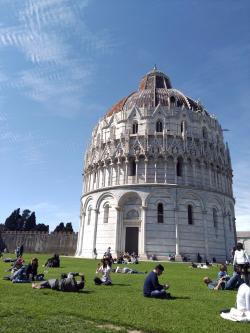The Declaration of Outstanding Universal Value

"In a restricted area bounded by the ancient City walls, the historic Ospedale della Misericordia and the Palazzo dell'Arcivescovado, the Piazza del Duomo, or Campo dei Miracoli (1) in Pisa, contains one of the most famous and surprising urban landscapes in the world.
The unique, fundamental Christian religious architectural works (Church, Cathedral, Baptistery, Bell Tower, Cemetery) were built between the 11th and 14th centuries in close proximity to each other, forming a unique set of monuments.
A magical quality pervades the Site, emanating from the glittering interplay of marble and mosaics, from the unusual union of bare walls and arched galleries, triangular pediments and large domes, which whole effect, definitely accentuated by the breathtaking inclination of the Bell Tower, the famous Pendant Tower of Pisa".
The Declaration of Outstanding Universal Value contains the reasons that led to the inclusion of Piazza del Duomo in Pisa in the World Heritage List. The document consists of a brief description of the Site (Brief synthesis); the methods by which it meets the selection criteria adopted; a declaration of integrity (Integrity) and authenticity (Authenticity); the management methodology for the protection of the assets (Protection and management requirements); and it constitutes the reference point for the development of the Management Plan. Through the content of the Declaration, in fact, the Plan defines the significant value of the World Heritage Site, setting the context for understanding its important qualities in order to determine the actions necessary to protect and manage it.
The UNESCO World Heritage Center conferred the title of World Heritage Site of Piazza del Duomo in 1987, on the occasion of the eleventh Conference of the World Heritage Committee
The UNESCO World Heritage Center recognizes the Pisan Site as an architectural unicum that has inspired, over the centuries, the works carried out in the City and in Tuscany. The monuments in Piazza del Duomo influenced the development of much of the sacred architecture later on, especially in the use, for decorative purposes, of polychrome marbles and loggias. In the City, there is the Church of Santa Maria della Spina, the Church di San Michele in Borgo, the Church di San Pietro in Vinculis, and the Church di San Paolo all'Orto; while the parish Churches in Sardinia and Corsica, for example, bear witness to the great territorial resonance of Pisa, starting from year 1000, as a maritime republic.
The architectural and decorative components of the monuments that embellish Piazza del Duomo are the result of numerous local workers. Here are found fragments taken from the theories of the Arezzo’s art historian Mario Salmi, a professor at the University of Pisa, who devoted great effort to the study of Tuscan Romanesque:
"The architecture known as Pisan Romanesque, which for about three centuries had undisputed dominion over a large area of Tuscany, Sardinia and Corsica, proposed – as it is known – decorative purposes outside the Churches".
Furthermore, the importance of the Site lies in its extraordinary architectural innovation, widely debated over the times. The Cathedral, in fact, built starting in 1063 and inaugurated in 1118, richly decorated and with an ornamental style with blind arches, was designed by the architect Buscheto, who was succeeded by Rainaldo, who strictly respected the style of his predecessor. For the construction of the religious building, the two masters employed all the most modern technical-scientific knowledge of the time, rendering the complex a universally recognizable and appreciated masterpiece, for its repetitive logic of the architectural elements (first the loggia) and decorative elements (such as the distinctive use of polychrome marbles).
 The main body of the building was designed and built with a Latin cross structure with five naves, according to the layout wanted by Buscheto and then further elaborated by Rainaldo. The latter also created the external facade by importing stylistic elements of oriental influence, whose use in Pisan architecture was favored by the trade exchanges that the Maritime Republic conducted with the rest of the world.
The main body of the building was designed and built with a Latin cross structure with five naves, according to the layout wanted by Buscheto and then further elaborated by Rainaldo. The latter also created the external facade by importing stylistic elements of oriental influence, whose use in Pisan architecture was favored by the trade exchanges that the Maritime Republic conducted with the rest of the world.
The entire monumental complex of Piazza del Duomo, while inspired by heterogeneous styles of a both local and international matrix, shows a heterogeneity of execution that establishes as a virtuous example of architecture, innovative and unique in its kind. Salmi, among many, confirms this writing:
Finally, it is not surprising that Piazza del Duomo in Pisa is an identity symbol of considerable importance for Italy: the Leaning Tower. Perhaps the most famous tower in the world, the leaning tower is undoubtedly an emblem of Italian art abroad. Built between 1173 and 1350, based on a project by a still unknown architect, the Bell Tower represents an extraordinary architectural feat, famous for its slope due to the clayey soil on which it was built.
Note:
- The popular term Campo (or Piazza) dei Miracoli derives from the term miracles, which the poet Gabriele d'Annunzio used to define the four most important monuments contained therein (Cathedral, Baptistery, Camposanto and Campanile), by virtue of their characteristics of beauty , originality, and social and religious function within the City community, in the famous novel “Forse che sì, forse che no” (1910).
- Evaluation of the Advisory Body (ICOMOS) for the registration of the Piazza Duomo in Pisa Site, 1987 https://whc.unesco.org/en/list/395/documents/
